Apple iPad mini with Retina Display: Reviewed
by Anand Lal Shimpi on November 16, 2013 8:00 AM ESTThe SoC
The iPad mini with Retina Display rounds out the three platforms that use Apple’s A7 SoC. Although both the iPad Air and iPhone 5S use the A7, the mini’s implementation is closer in nature to the iPhone. The iPad mini’s SoC has always used the same package-on-package (PoP) assembly as the iPhone, with DRAM stacked on top of the SoC itself (1GB in this case). The benefit is obviously a reduction in board area, the downsides have to do with cost and thermals. That’s the first similarity between the mini’s A7 and the iPhone’s A7.
The second is one of frequencies. While the iPad Air’s A7 runs its two Cyclone CPU cores at up to 1.4GHz, the SoC in the iPad mini and the iPhone 5S runs at up to 1.3GHz. That might sound like a minor difference, but it’s far more pronounced when you look at what happens to frequency when you’re running heavy workloads.
Once again I turn to a fairly heavy CPU workload to plot performance over time. This is a multithreaded workload, slightly modified from what we used in the iPad Air review, designed to make the CPU cores consume max power. The scale is linear and the workload is the same across all devices, so what you’re effectively looking at is a graph of thermally bound CPU performance over time across all three A7 implementations:
Being the largest device (and the only device with a metal heat spreader and no DRAM stacked on top), the iPad Air obviously maintains the highest frequencies for the duration of the test. The iPhone 5S, with a significant reduction in internal volume (and a PoP SoC) reduces its CPU frequencies early on in order to keep skin temperature down and properly manage thermals. The iPad mini with Retina Display falls between the two, with its performance curve more closely following that of the iPhone 5S.
Although the mini has a similar max operating frequency to the iPhone 5S, it is a faster device thanks to it being less thermally constrained. Similarly, the iPad Air can be much faster than its clock speed would otherwise imply. If you’re wondering why Apple has been so focused on building its own SoCs and CPU architectures, this is the reason why. There’s a fixed amount of power you can dissipate in the form of heat in these mobile devices while still maintaining a good user experience. Performance per watt is the gating metric for success in mobile, and shipping high IPC/low frequency dual-core SoCs at 32/28nm is the best optimization available to a company like Apple today.
As you’d expect, our browser based CPU tests show the mini’s A7 performing in between the iPhone 5S and iPad Air. None of these tests are anywhere near as stressful as our thermal test from above, so we don’t see exaggerated differences in performance between the platforms. For most, I suspect you won’t notice a huge performance difference between the mini and Air. Those who are heavier users (e.g. audio mixing, 3D gaming, etc…), there will be a performance difference between the two iPads.
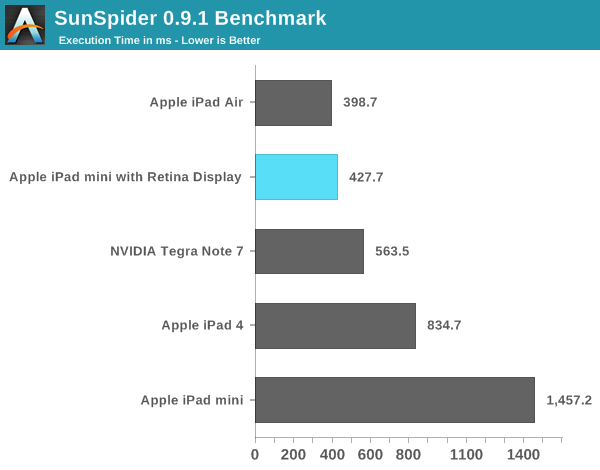

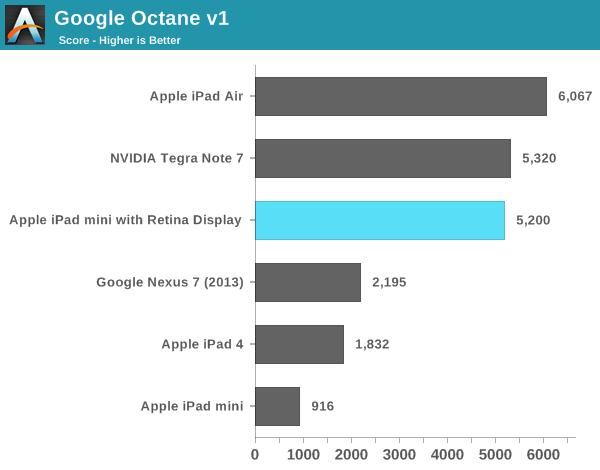
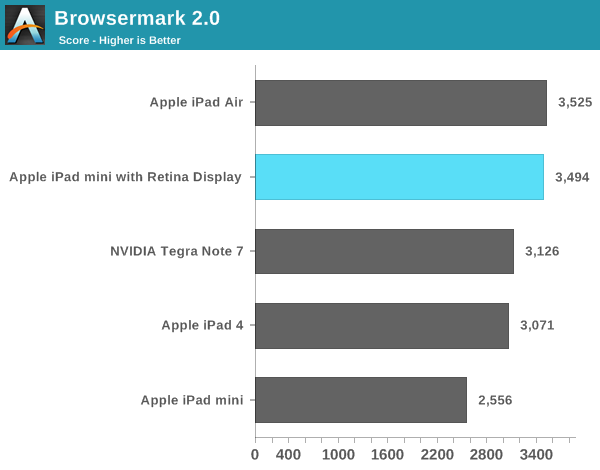
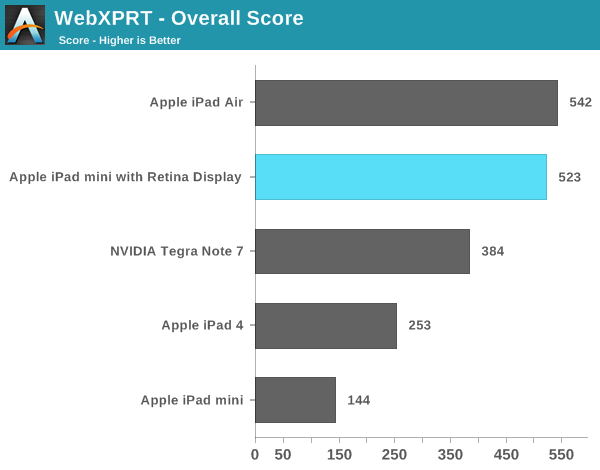
Compared to the first generation iPad mini, the new model is in a completely different performance league. Keep in mind the first mini used Apple’s A5 SoC based on an ARM Cortex A9. That’s the same single threaded performance as what’s in an iPhone 4S, and under iOS 7 it’s clearly running into some performance limits. The new mini with Retina Display however is a completely different animal. It’s fast.
Even comparing to the 4th generation iPad, the new mini is noticeably quicker.
Memory Bandwidth
Looking at the iPad mini’s memory bandwidth curve, we see it tracks very closely with that of the iPhone 5S. This is a slightly modified version of our previous bandwidth test, and you can see peak usable memory bandwidth (from the CPU’s perspective) of around 10GB/s. The ~12GB/s area right before you get out to main memory is bandwidth to the A7’s 4MB system-wide cache that sits after the shared L2 and the memory controller. This cache appears to service CPU, GPU and ISP requests at least.
GPU Performance
I believe the A7’s PowerVR G6430 GPU runs at around 450MHz. This frequency appears unchanged across all three A7 implementations. Once again, the big difference is how much thermal headroom exists in the platform which has an impact on overall performance.
Kishonti’s low level GPU performance tests back up my assertion that GPU frequency is fixed across all A7s. The iPad mini with Retina Display delivers equal performance to the iPad Air. The bigger news here is that nearly all of the GPU bound 3D tests seems to peg the mini and Air as equals. These are some pretty intense tests, but it looks like on the GPU side there’s no significant throttling when running at full tilt.
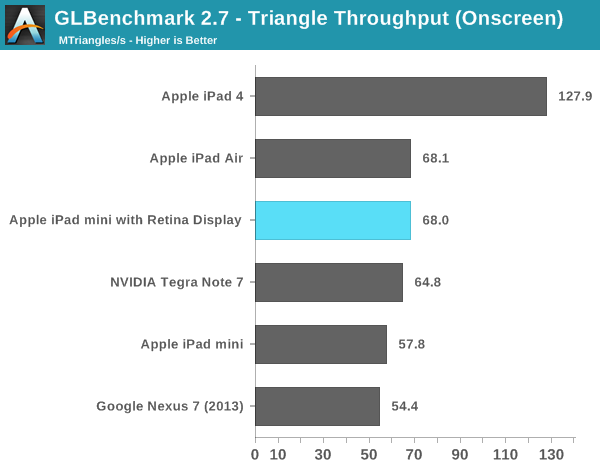

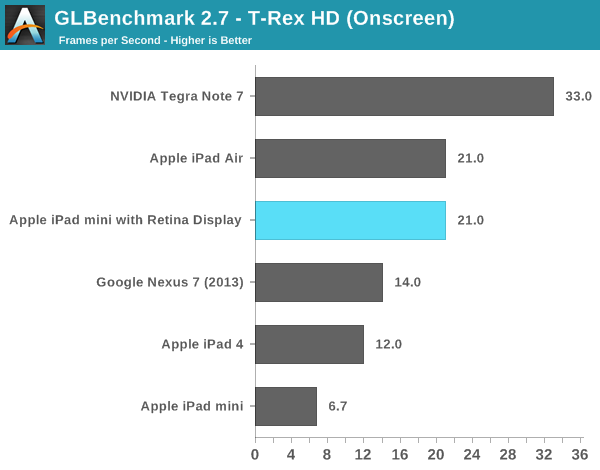

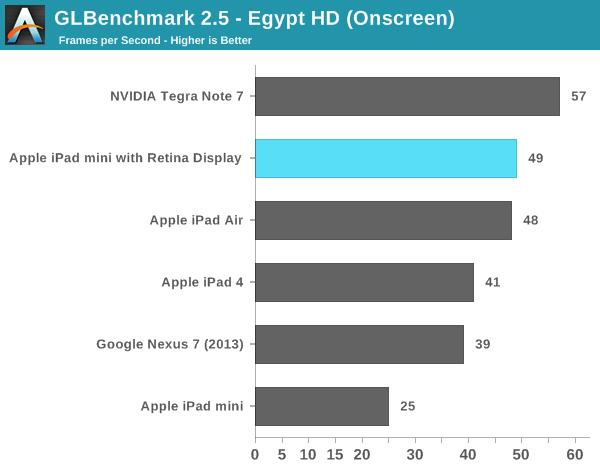
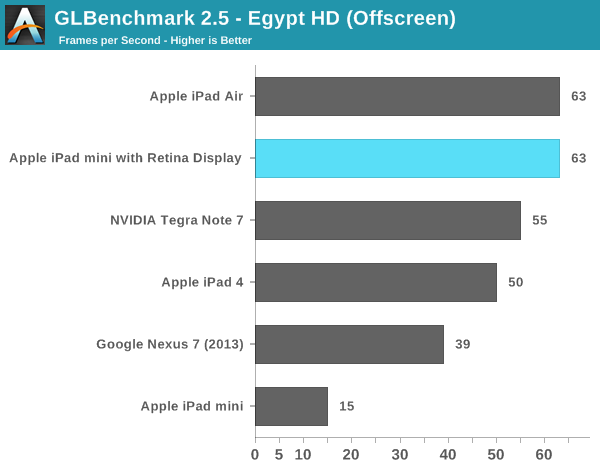
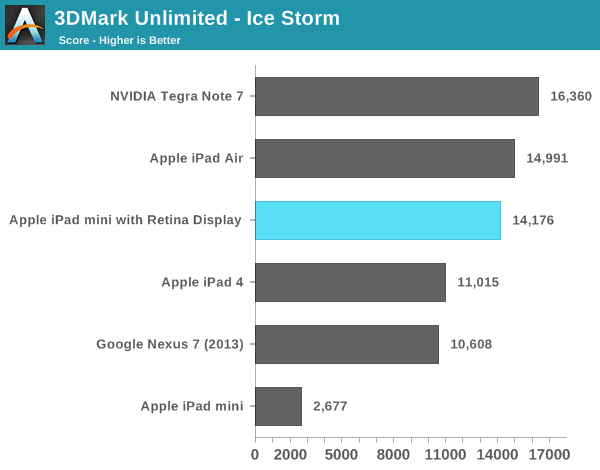
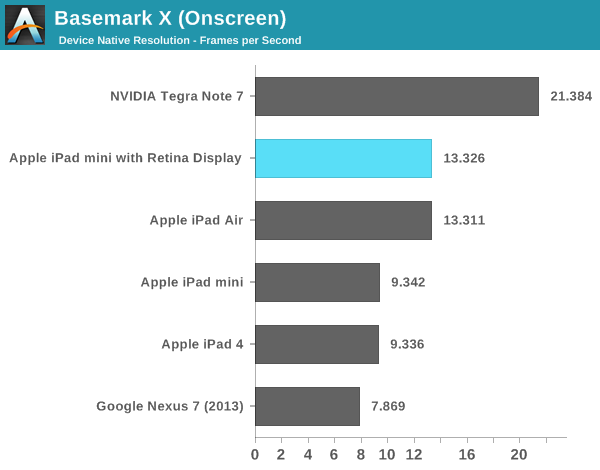
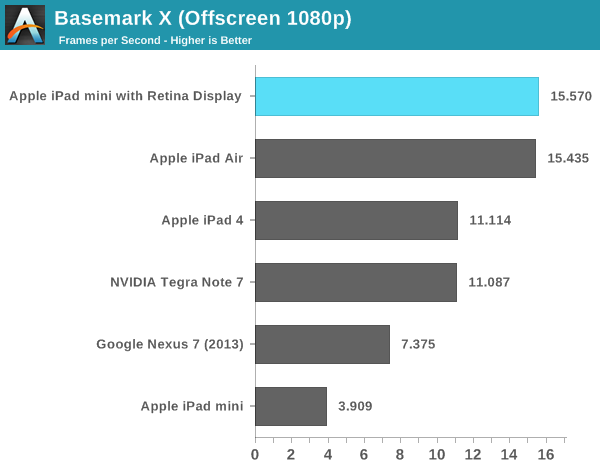
As I mentioned in our iPad Air review, despite having less peak theoretical memory bandwidth than the A5X/A6X, the A7 in the iPad mini never seems to regress in performance compared to even the iPad 4. Across the board the mini appears to be faster, more responsive and have more performance on tap than any prior iPad (big or small). The comparison to the original iPad mini is of course night and day. Even looking at lighter tests like the old GLBench Egypt HD benchmark, the iPad mini with Retina Display manages to be nearly twice as fast as the original mini - all while rendering 4x the number of pixels.


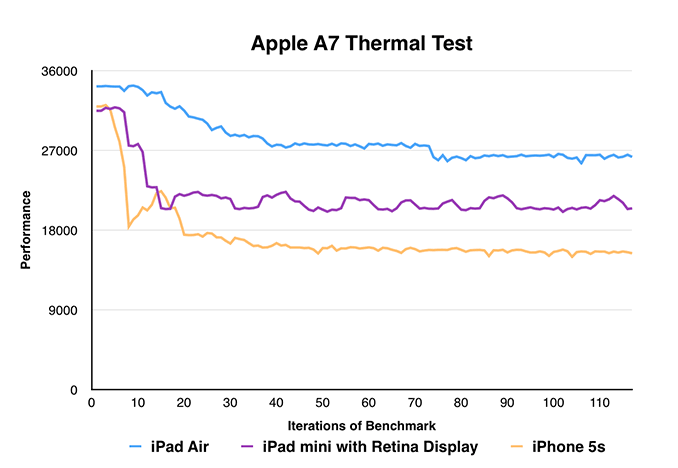
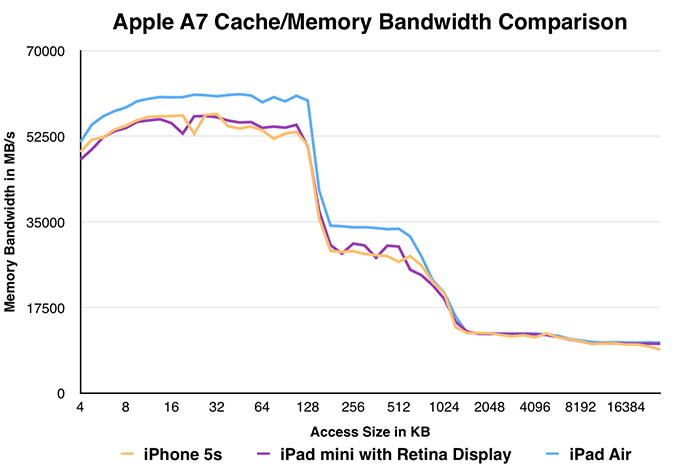








345 Comments
View All Comments
kyuu - Saturday, November 16, 2013 - link
Bay Trail tabs seem to be charging $50 to go from 32GB to 64GB (32GB upgrade). While still more of a premium than it really should be for cheap eMMC NAND, it's a helluva lot better than the $100 for 16GB to 32GB (16GB upgrade) Apple is sticking with.Daniel Egger - Saturday, November 16, 2013 - link
And which *premium* devices are you talking about? The 2 different vendors offering different memory configurations with BayTrail are Asus and Toshiba. Both are not premium and yet Toshiba is asking 50€ to go from 32GB to 64GB and ASUS even 80€ for the same. Dell, HP and Lenovo only offer one configuration at the moment.Anywhoo, while Apple is not cheap they're by far not the most expensive (see HTC, but there're other examples as well) and they're very consistent in their pricing and go all the way up to 128GB.
kyuu - Saturday, November 16, 2013 - link
Huh? I didn't use the word "premium" in the context of a device being nice or not, so I don't know why you're bringing it up that way. The build quality of many of the Windows tabs are equal to, if not better than, the iPad anyway.I'm actually not aware of any Win8.1 tabs that don't have different memory configurations, and none of them charge $100 for 16GB of NAND, or even for 32GB of NAND. I don't understand what you're trying to get at. I couldn't care less if Apple goes up to 128GB of NAND when they're charging $300 for ~$20 worth of NAND.
Also, it's certainly not "consistent" to charge $100 for 16GB of NAND, then $100 for 32GB of NAND, then $100 for 64GB of NAND.
akdj - Sunday, November 17, 2013 - link
These aren't SanDisk Best Buy SD cards they're shipping. Look at the pricing on decent flash memory, IE, CompactFlash. All manufacturers using real NAND are paying many more dollars than 5 per doubling of capacity. Probably with Windows, the OS and it's bloat take UP all the NAND....and I'm not sure the world you're living in, but there's not a single Win8.1 tablet that comes close to the build quality....of even the earliest of iPads. The new Air and rMini....works of engineering art. Top shelf. Doesn't get ANY better. Certainly not Win 8.1 tablets. Sorry.Morawka - Sunday, November 17, 2013 - link
Nand at these capacities is dirt cheap. Think of how many 16GB chips are in a 128GB Consumer SSD? 8 of them. And the ssd's MSRP is $119 and included in that cost is a storage controller, casing, PCB, and of course, NAND.When you pay for a apple nand upgrade, your just paying for more nand, period.
kwrzesien - Monday, November 18, 2013 - link
Your right, they pay WAY more. BOM increase for 32GB over 16GB is $13! That's over double $5!/s
RadarTheKat - Monday, November 18, 2013 - link
And how much is the Surface keyboard, without which the device is not very usable? Talk about gouging your customers!Puberticus - Saturday, November 16, 2013 - link
Ever bothered to see what the speed of those chips are? I think you'll be shocked. Apple isn't shipping crap.kyuu - Monday, November 18, 2013 - link
I've looked before and haven't been able to find any reports about the speed of the NAND Apple uses, since, y'know, there's no way to benchmark it on Apple's locked-down and functionally gimped OS.Regardless of whether it's good NAND or not, it's still $5-$10 worth of NAND.
Morawka - Sunday, November 17, 2013 - link
Here in America going from a HTC One 32GB to a HTC One 64GB is only $70 more. The 64GB version was supposed to be a AT&T Exclusive from my understanding. Just view their website if you dont believe me.Whoever your buying from is gouging prices. lol